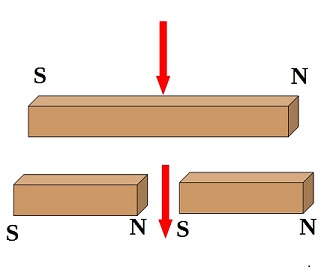
All Solutions
Section 22.1: Magnets and Magnetic Fields
In a bar magnet, the magnetic field lines enter the magnet at the south pole and leaves the magnet at the north pole. So the direction of the magnetic field of a bar magnet is towards its south pole.
If the compass is placed near the south pole of a bar magnet, the direction of the needle is towards the south pole of the bar magnet.
If it is placed near the north pole the needle points away from the north pole.
Hence isolated magnetic fields cannot be created by breaking a bar magnet into two pieces.
If a bar magnet is broken into two pieces, at the broken ends, opposite poles are formed so that each broken piece behaves as a smaller bar magnet as shown below.
Because at the poles, the magnetic field lines lie closer to each other than at equator. So the strength of the magnetic field is higher at the poles than at the equator.
In Antarctica, Earth’s magnetic field lines leave the Earth and hence the magnetic field points away from the Earth’s surface.
(2) Opposite charges attract each other and like charges repel each other. Similarly, opposite poles attract each other and like poles repel each other.
(3) Isolated electric charges exits but in contrast, isolated magnetic poles or magnetic poles do not exist.
In some pieces of irons, the net magnetization might not be cancelled so they behave like a magnet while in other pieces, the net magnetization might be cancelled, so they do not behave as magnet.
Haven't found what you were looking for?
Search for samples, answers to your questions and flashcards

